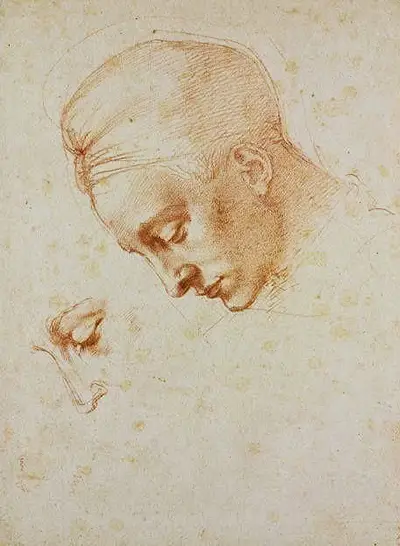Leda and the Swan is a theme that derives from Greek mythlogy and also appears in a number of other famous artist's careers. The completed painting would change hands several times before finally being lost, leaving behind several copies, some more faithful to the original than others. The photograph included here is of one of his many study drawings that were produced prior to beginning the final painting. He was also involved in a number of other projects at this time, including his extraordinary series of frescos for the ceiling of the Sistine Chapel, which remains amongst the highlights of his entire career. Michelangelo was a man of many talents, but his skills as a draughtsman were extraordinary and even just the simple piece pictured here can amaze and astound those lucky enough to view it in person. He understood the important of practice and repetition within depictions of anatomy and so would spend hour after hour making copies of drawings from all manner of different sources of inspiration.
There is a copy of the original painting at the National Gallery and that gives us the best example of how it looked before being lost. Leda herself reclines on some comfortable furniture with her head bowed - therefore the drawing included here is confirmed as being her face. The painting captures her in full length, without any clothes, just with some swans behind her. The problem for academics is that whilst this gives us a good idea of what went on in the original, and also that is fits closely with the drawings that were from his hand, we cannot be sure as to how accurate it is to the original painting. This is a common issue with studying artists from so many centuries ago, and although Michelangelo is perhaps the most researched of them all, there are still many different questionmarks that remain unanswered and will likely remain that way forever.
Leda and the Swan can be found in examples of art and antiquities going back many, many years. A Roman oil lamp exists from 1st century AD with the base designed around this theme, and there are also some stunning mosaics from around that period too. In terms of paintings, there was also Leda and the Swan by Correggio and also a version from Da Vinci which was also sadly lost. Appearances within the past few centuries are much rarer, but Paul Cezanne did produce his own version. The topic involves a swan being the god of Zeus in disguise, in order to get Leda to drop her own protection. He would then force himself upon her. Other interpretations of the content were found in later periods of Greek mythology but this generally regarded as the meaning.


